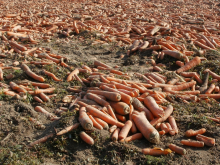 |
| Food waste - a growing problem? |
Food loss and waste could increase by a third by the year 2030 unless urgent action is taken by governments, companies and consumers. This is the warning of a new report released by Boston Consulting Group (BCG). Currently, 1.6 billion tons
of food worth about $1.2 trillion are being lost or wasted each year. According to a model developed by the consulting firm, food loss and waste could grow at an alarming rate, reaching 2.1 billion tons of produce worth $1.5 trillion by 2030. Significant spikes are expected in Asia, especially in industrializing countries with growing populations. “As wealth grows, people are demanding more food, more diverse food, food that is not grown locally. That’s going to increase food loss and waste,” co-author Shalini Unnikrishnan told The Guardian.
The report outlines that food loss or waste occurs at all steps in the value chain but is most pronounced at the beginning (production) and at the end (consumption). In developing countries, it happens mainly during production and transportation of food from farms, while in developed countries the problem is most prevalent in the consumption phase, among both retailers and consumers. “Roughly one-third of the food produced around the world goes to waste,” says Esben Hegnsholt, co-author of the publication. “This represents a challenge so massive that it was included in the United Nations’ Sustainable Development Goals. But while it is a daunting problem, there are steps that can be taken today, actions that draw on currently available technology and know-how, to dramatically slash food loss and waste across the value chain.”
The report presents five key drivers of the problem: lack of awareness among consumers and others, inadequate supply chain infrastructure, supply chain inefficiency, a lack of collaboration among groups across the food value chain, and poorly designed tax and regulatory policies. If those drivers are addressed, the dollar value of annual food loss and waste could be reduced by nearly $700 billion. Increasing awareness among all stakeholders alone could reduce the problem by $260 billion a year. The authors also state that regulations, industry standards, and tax policy have generally not been put in place or designed with an eye toward minimizing food loss and waste and encouraging efficient repurposing. They point out that disposing of food waste remains very cheap, and tax policies do not penalize companies and consumers for the waste they create and there are no incentives to cut waste. Regulations, taxes, and policies that encourage finding another valuable use for food and the recycling of it into the highest value products possible could reduce the problem by $110 billion per year.
BCG stress that real progress can only be achieved through commitment and coordinated action from consumers, governments, NGOs, farmers, and companies. The group says businesses can make an important contribution to cutting food waste: “While many stakeholders have a part to play in combating food loss and waste, the role of companies is perhaps the most critical,” according to Unnikrishnan. “Companies are involved in every aspect of the food supply chain, from production to consumption, and as a result, their decisions and actions have an outsized impact. At the same time, they have deep expertise, insight on potential solutions, and the money to make those solutions happen.”









No comments:
Post a Comment